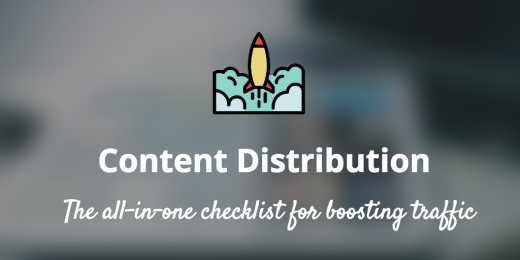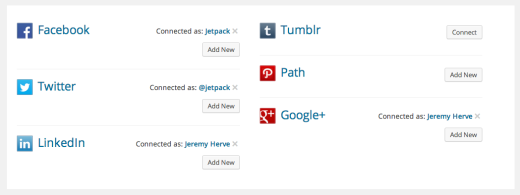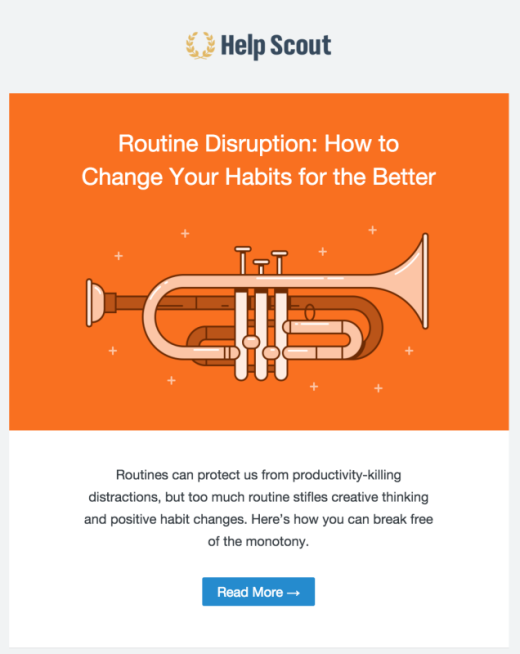
You’ve written a fantastic blog post.
Now . . . how are people going to find it?
It’s a question most of us bloggers deal with every single time we hit “Publish.”
Wouldn’t it be awesome if there were a list of things that we could do tobring in some traffic right off the bat—even if the post wasn’t a super-brilliant infographic or 5,000-word masterpiece?
Maybe there is.
I’m excited to share a list of nine ways I’ve found to drive traffic to new blog posts: a checklist of sorts that can help you see how to bring some lift to every new piece of content you publish.

The Content Distribution Checklist
9 ways to bring more traffic to every blog post
1. Post to all your (relevant) social accounts
Once your blog post is live, an easy way to immediately get some exposure is to push it to your social accounts.
(Hint: This is especially easy to do if you’re using an auto-publish plugin, such as the JetPack plugin for WordPress.)

Posting to your social media accounts right away can be a nice way to let your followers know about your latest post.
Some people choose to announce a new post with a little tagline at the start, making special note that the content is new. Here are a couple of my favorite was I’ve seen (and an example from the ProBlogger Twitter account):
- “New post: [headline here]”
- “My latest from the blog: [headline here]”
New at ProBlogger: Tools to Help You Optimize Blog Headlines and Content https://t.co/QTAjy1c2bo
— Darren Rowse (@problogger) October 20, 2015
Pro-tip: Not all posts are suitable for all social accounts. (For instance, an article on Twitter tips might not make sense to share as much on Facebook.) You may want to consider how your following may differ across social accounts, just to make sure your updates make sense!
2. Post 6 updates to Twitter
Tweets tend to have a shorter shelf life than other social media posts. They’re quickly buried under new tweets—whether it’s new tweets from you on your own profile or new tweets from other people your audience follows. A single tweet from our buffer Twitter account for example, reaches about four percent of our followers.
That means that if you’re only sharing your blog post to Twitter once, you only have one shot at getting your audience to see it.
(Which might be a little risky!)
One possible solution is to share articles on Twitter more than once.
Even up to six times or more!
That may sound a little bit like cheating at first, but Belle Beth Cooper has found three killer benefits you can get by sharing a post to Twitter multiple times:
- You can get more traffic and engagement. In fact, a Wisemetrics study found that, on average, the second tweet gets 86 percent as much performance as the first one. And the returns keep coming in. Even after an article is shared six times, it can still bring in around 67 percent of the first tweet’s engagement. (HT to Kevan Lee for finding this study!)
- You hit multiple time zones. (There’s a good chance some of your followers are sound asleep or hard at work when you hit “Publish”!)
- You reach your newer followers. If you spread your re-shares over months, you’ll be picking up new followers between those shares. That means that your “old” content may still be new to them!
3. Email (or Slack, or HipChat) your internal team
The job of content distribution doesn’t have to be completely on you. Your coworkers and teammates may be able to share your awesome content with their followers, too.
However, you’ve probably noticed that if you’re hard at work, it’s not easy to know what your teammates are up to. They’re probably in the same boat: they don’t necessarily know thatyou’re writing awesome stuff.
So, one way to start distributing your content is to let your team know about new blog posts! Sending an office email can score a few big wins:
- Your whole team will be up to date. Your sales team will know of new assets to refer potential customers to. Your customer service team will know about helpful advice to share with new customers. Your boss will know what’s going live. A quick email gets everyone on the same page.
- Your team can give you some input. There have been a few times I’ve hit “Publish” a little too soon, but my teammates were able to catch a few errors or give me some direction before it got in front of any customer eyeballs.
- Your team can seed that content with social proof! If a few of your coworkers share that new article, then your audience will hit a page that already has some numbers beside those social share buttons.
Slack, Hipchat, and other messaging apps are a great option also if more of your team communication happens there versus email. Both IFTTT and Zapier offer some neat automation so that every time a new post is published a notification appears in the room!

Here’s a sample from the Buffer hipchat room, notifying the team of a great new post!

4. Notify your email list
Thus far, you’ve given this post a little lift from your social followers and internal team. Let’s look at a few ways to seed it with some more traffic.
One way to send a great deal more traffic to your post is to send a note to your email list. This can score a few wins:
- More people heading to your post increases your chance of getting more social shares.
- Sending a note to your email list helps people feel like insiders—like they’re among the first to know about the awesome new content you’re making!
A popular way to accomplish this is through an RSS email campaign with MailChimp, Aweber, Campaign Monitor, or other email tools. This allows for your posts to go out automatically to your subscribers every time you publish (more on email strategies here).
Here’s a great outreach email from Help Scout as an example:

5. Reach out to relevant friends
If you’ve published an article that you just KNOW is going to be appealing to a few of your friends, it might help to reach out to them specifically. For example, let’s say you’ve published a blog post on why cats are superior to dogs in every way. You have a few friends who really love their kitties—people who would absolutely love an article like this.
One way to get a little social traction on a fresh blog post is to ping these friends and let them know about it!
6. Reach out to the influencers mentioned in your article
If you’ve mentioned any influencers in your article, one way to get a little more distribution is to let those influencers know that you’ve given them a nod. (They may turn around and share it!)
The cool thing about this strategy is that you don’t have to be a super-important celebrity in order to make it work. All you need to do is mention someone influential (in a way that makes them look good), and then reach out to them about it.
(By the way, this strategy has had a 66 percent success rate for the Buffer team!)
It can be as simple as this brilliant email Kevan sent to the Twibble team:

7. Reach out to influencers on the topic
There may be some influencers in your niche who share cool stuff from around the web every once in a while. If so, you might have a shot at getting them to share this awesome content you’ve created! You can send these influencers a quick email or tweet letting them know about that terrific post you just wrote.
Reaching out to influencers isn’t easy. Here are a few pointers to keep in mind that have proven valuable for me:
- Influencers are usually short on time (so it may help to keep your messages brief).
- Influencers are used to people asking them for favors (so it may help to let your content speak for itself, instead of directly asking for a share).
- Influencers are real people, and real people like to feel respected (so it may help to make the message all about them). ?
Pro-tip: as a general rule, the higher-profile the influencer, the slimmer your margin of error can be. It might help to warm up your outreach skills on the lesser-known names in your niche first. (That’s what I did, and it really took the pressure off!)
8. Use your blog post to answer questions on Quora and Reddit
Another way to pull in some initial traffic for your post is to use it to answer some questions that people are already asking. This is where forums and social networks like Reddit and Quora can really come in handy.
For example, suppose you wrote a post on using Google Analytics for social media marketing. It’s a fantastic article that answers all the tough questions you wish someone had helped you with when you were getting started.
Now, what if you could share it with the people asking those same tough questions today?
By searching Quora or Reddit for “Social media Google Analytics,” you can find those people and those questions. Then you can answer them (and give the readers a link to your article for further reading).
Note: People ask questions on these networks to find answers, so make sure you’re genuinely answering the questions they ask, not just linking to your own blog. ?
9. Set up a Google Alert
You’ve put all this effort into creating and promoting a sweet blog post. Now you may want to consider going the extra mile: setting up ways to promote it long-term.
One way to do this is to stay informed about new posts and conversations about the topic you just wrote about. A method you may want to try: setting up some Google Alerts for some of the key concepts in your article.
For example, let’s say you wanted to get an email about new blog posts and forum threads about social media and Google Analytics. You could set that up in just a few quick steps:
- Go to Google.com/alerts
- Slap “Social media Google Analytics” into the search bar.
- Hit “Create Alert”
BAM! Now you’ll get an email when Google finds a new article that mentions this topic. This can make it easier to find conversations about this topic—especially in article comments!
A helpful aspect of this approach is that it pings you about new promotion opportunities long-term, so you don’t need to mentally set aside time to go back and promote old posts.
Over to you
I’m curious: how do you promote and distribute your blog posts? I’d love to hear about what has worked for you! I’ll be hanging out in the comments if you want to chat about it.
Want to download & print this checklist? We’d love to email it to you!
Note from the Buffer team: We’re really grateful for Jeffrey covering these nine ways to promote a new blog post and would love to make it easy for you to run through this checklist every time!
This post first appeared on Buffer.
Get the TNW newsletter
Get the most important tech news in your inbox each week.





